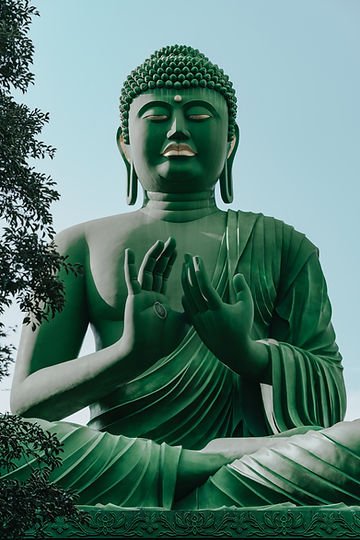What Is Meditation?
Meditation is a cultural phenomenon. It’s been around for thousands of years, and it isn’t going anywhere. What is meditation? How does somebody meditate? We will answer those questions and others in this article
In the simplest terms, meditation is the practice of focusing one’s mind, body, and spirit on a singular idea, thing, or action. When teaching someone to meditate, we start with a color. We will do a simple practice to focus the student’s minds by asking them to close their eyes and think about the color white. An interesting thing happens when you try to focus on something. Everything that you don’t want to focus on will pop into your head! This is invariable among humans. Trying not to focus on something will invariably cause you to focus on it. The more you try to focus on something, the more distractions will become noticeable. Focusing on the color white for an extended period without allowing distractions or blemishes on your plain white canvas is challenging. So the practice of meditation is very much the theory of meditation. Focus your mind.

The mind is like a muscle. To make the mind stronger, it takes exercise. Meditation is the practice of exercising the mind. A strong mind is a focused mind, and a focused mind is a productive mind. You may know people who have no focus, and if you are lucky, you may know someone who is focused. The unfocused individual will likely go through their lives without displaying a singular purpose or theme to their actions. But a person who has a tremendous amount of focus may be challenging to talk to about anything else. Take somebody who loves a specific video game to the point of obsession. They go to work, and they talk to their coworkers about the video game. All of their friends play the same video game, and when they’re together, they talk about the video game. When they have free time, they play the video game. When they have free time and cannot play the video game, you might find them watching YouTube videos, doing internet searches, or reading articles about their video game. This person is likely extremely good at that game. Of course, we don’t expect everybody to learn how to meditate so they can become better at a video game. But the video game example is one most people can relate to because we have all known someone like that.
Focus
What if you focused on something to the point of obsession? What if you practice your obsession with every spare moment of free time? What if you were so interested in it that when you couldn’t practice it, you could only think about it, read it, and watch a video about it? What if your focus was starting a business? Or raising your children? Or being a good husband or wife? It is invariably true that you would become better at whatever you focused on. Meditation is the practice of focusing. Sure, you can meditate on something specific. meditation has many uses. But at its core, meditation is simply the practice of focusing your mind. So are you ready to meditate? Great!
Let’s Meditate
Go to a comfortable, quiet room, close your eyes, and try to think of a plain white room. The room surrounds you. There is nothing else. Distractions will come into your mind; acknowledge them gently, and then dismiss them. Back to your white room. Back to nothing. Can you do it? I think not without practice! Perhaps you can do it for 15 or 30 seconds or even a minute. With time, meditation will allow you to have that level of focus over 30 minutes or an hour. Developing that mental muscle will help you focus on a singular purpose in your life.

How to Meditate:
Most people want to know how to meditate when they hear about the idea and its benefits. Meditating is simple. As described above, you can meditate on a specific color. But here, we will explore some other meditation practices that you can do to learn how to meditate.
To meditate, picture your goal. In this picture, place yourself in the woods. Imagine yourself walking through the woods. Imagine there are high trees with lots of leaves. Your mind will fill in a lot of the blanks. But it’s important to create intentional detail when possible. Think about walking through a forest. What kind of experience is that? Are you alone? When you meditate, you should imagine yourself walking through the forest alone. Now how do you feel? Are you scared? Exhilarated? Bored? Be honest with yourself. Now add some detail. We’ve already imagined trees with lots of leaves. Are there birds? Other bugs? Can you hear anything? Use your senses. Do you feel a breeze? Is it hot or cold? Can you smell anything? Do you taste the damp, warm air as it rushes into your mouth when you breathe? Focus on this for as long as you can. Close your eyes and walk through the forest. Voilà! You’re meditating!
Want more practice? Let’s say you encounter an animal. What kind of animal is it? Let’s say it’s a deer. Do you pet the deer? Or does it keep its distance? Will you follow the deer, or will it follow you? Or does it walk with you? There are a lot of question marks in this paragraph, but it’s essential to add this kind of detail to your meditation to be effective. When you have this much detail in your meditation, it’s easier to focus and hold the image in your mind. It also makes it easier to recall the picture later when you’re ready to meditate again. Don’t hold some vague idea of a forest where you walk around, and it’s this lifeless, skyless forest.

Who Should Meditate?
Meditation is a vastly versatile process. It can be used to calm oneself, break a habit, form a habit, and even change one’s perspective on a set of circumstances or a person. There’s a best-selling book, and now a movie, called “The Secret“. The main point of the philosophy within the book is that you will get whatever you focus on in your life. Positive or negative, you will get more of what you’re focused on. Meditation is a potent tool for focusing your mind. Something you want? Something you want to get rid of? Focus on it.
If there’s something you want, it’s pretty self-explanatory how you would meditate on it. Just focus on it. But if it’s something you don’t want, how do you meditate on it? After all, if you focus on what you don’t want, you’ll get more of it! To explain how this is done, I will use the same example used in the book. If you want to end a war, don’t focus on ending the war; focus on peace. So if you have a problem with anger, focus on calming yourself. If a particular person doesn’t treat you well, imagine that they treat you very well during your meditation. How does that make you feel? So who should meditate? Anybody who has something to gain. Anybody who wants to break a habit. Or anybody who has some personality flaw that they would like to get rid of. Meditation is for everyone.
What are the benefits of meditation?

The benefits of breaking a habit or creating one might seem obvious. If you’re a smoker and quit smoking through meditation, there are benefits to your health and hygiene. But what is the more profound benefit of meditation? Aside from the obvious and superficial benefits immediately visible on the surface, how does it improve a person when they meditate regularly? Meditation improves your mentality. Meditation improves your focus in all things. Meditation creates new pathways in the brain that you will follow automatically and apply to every situation without trying. The reason we can understand conceptual examples and apply them to different circumstances is the same reason that meditation is beneficial to you in all areas of your life.
If you only meditate to manifest a specific thing like money or to quit smoking, that, on the surface, may be the only benefit. But look a little deeper than that. If you meditate to quit smoking and it works, do you stop meditating altogether? Sadly, many people do. They think meditation is only beneficial when you want something or want to get rid of something. When they quit smoking with meditation though, they taught themselves how to control their subconscious mind. Control over the subconscious mind is an elusive thing. You just can’t give your subconscious mind a command the way you can when you choose to move your arm. If you want to bend your arm, you bend your arm. You don’t try, and you don’t meditate on it. You just do it. Your subconscious mind does not work that way. For example, some people use meditation to slow their heart rate. Some people can bring their heart rate

almost to a complete stop with meditation. That kind of control over “involuntary muscles“ is the kind of control we have over our subconscious. Our subconscious is the “involuntary muscle“ of the brain. It acts without our knowledge often and always without being told. So what control do we have over our subconscious mind? Surprisingly, we have a lot of control over it. But just like our heart rate, it takes meditation.
You must teach your subconscious mind. Train your focus. Don’t just say to yourself, “I want to quit smoking”. Your conscious mind acts as a filter to your subconscious mind, and it will automatically correct you by saying, “you are a smoker”. Since you’ve been smoking for so many years, your conscious mind knows that you are a smoker. Your subconscious mind simply follows the pathways laid out by your conscious mind. For such control of your subconscious mind to change your habits and behaviors on a deeper level, you must create new mental pathways for your subconscious mind to follow. This is scientifically proven. We can create new neural pathways in our brain and make permanent, profound changes to our thought processes and behaviors. The military has done experiments with behavioral modification, and often doctors or the military have used drugs for this purpose. Some shamans use a drug called “DMT“. This drug opens your mind in ways that are considered dangerous, even though there is not a single recorded case of a DMT overdose. The actual “trip“ that you get when you take DMT is often life-changing, and it only lasts for 15 minutes. We do not suggest using drugs.

We do not suggest going to a shaman or allowing the military to run experiments on your brain. Meditation, over time, will have a powerful effect and re-write your mental pathways. The most significant benefit of meditation is creating new neural pathways in the brain and controlling your subconscious mind, thereby controlling your behavior without effort. Think of it like this, if you drive to work every day the same way for 20 years and then change jobs, you may find yourself on “auto-pilot“, where you end up at your old job by accident. This may happen multiple times before you drive automatically to your new job. You may even get frustrated because you automatically do something you don’t intend to do simply out of habit. Meditation allows us to create new neural pathways and overcome the “autopilot“ of our subconscious brain.
How to “Manifest” Something using Meditation:
We have touched on this previously in this article. When we say “you will get whatever you focus on“, that is, indirectly, the answer to this question. How do you manifest something? Meditate on it. But specifically, meditate on the way you will feel when you have it. Meditation is all about emotion. If you think about something, but you don’t feel it, it would have minimal benefit for you. Do you want to find the love of your life? Focus on how you will feel once you have found them. How do you feel when you’re alone thinking about them? How do you feel when you’re with them?
People do not fall in love with other people. Psychology has taught us that people fall in love with the way other people make them feel. This is a significant differentiation when you are looking for someone to love. If you want to find a person who will be the love of your life, how do you feel when you are with this person. In addition to that, meditate on how you will feel after meeting this person, but you are alone. How does your self-talk change? How do your thoughts and emotions change after you have found the love of your life? When you are with them, how do they make you feel?
Knowing the answers to these questions and meditating on them is how you will attract or “manifest“ circumstances that will lead to you finding the love of your life. When it happens, it will seem like magic or an act of God. That is not the case. Of course, I won’t take anything away from God if you believe in him, but let me put it in terms that everyone can agree with.

Let’s say you go out and buy a car. Your car is a red Ford Focus. When you first buy your car, maybe you are familiar with it, but you think it is unique. You’re proud of your red Ford Focus. But after you buy the car and drive around in it, you begin to see red Ford Focuses everywhere. It occurs to you that your car isn’t so unique after all. It didn’t become more or less common because you bought the car. Of course, reasonable people realize that. It’s simply a psychological trick. Our mind is amazingly powerful. You didn’t notice how many red Ford focuses there were because you weren’t focused on it.
In the same way, focusing on circumstances that would help you meet the love of your life will cause you to notice those circumstances more readily. Perhaps the opportunity to meet the love of your life has come and gone dozens of times throughout your life, but you just didn’t notice it. Once you begin to focus on it, imagine it, and meditate on it, the circumstances that would lead to you meeting the love of your life will become obvious everywhere. Opportunities will seem endless. You will magically end up in various circumstances throughout your day that would be conducive to achieving your goal of meeting Mr. or Mrs. Right.
Humans tend to notice what we want to see only what they want and not what we don’t want to. If you tell yourself it’s impossible to meet someone you will truly love, your brain will block out those opportunities. You will be blind to them. The power of the mind allows us to block out circumstances, memories, and truths that we don’t want to see. In the same way, you can make yourself see what you want to see in various circumstances. You have the freedom of choice in your life, and you can choose whether or not you see and take advantage of opportunities as they come.

How to Break Habits With Meditation:
You have heard of people who quit smoking using meditation. In the last paragraph, we talked about how someone can override the effect of “autopilot“ in their behavior using meditation. Here I will go into more detail about exactly what to do during your meditations to break a habit using smoking as an example throughout the paragraph. Although we use smoking as an example, you can apply this meditation practice to any habit you wish to break.
Let’s go back to our forest. We have been walking around during our meditations as a matter of practice. Now we will go deeper into the forest and use our meditation to quit smoking. The first thing you should do is walk around in your forest. You have to meditate for a while. Not 30 minutes; that might be the entire length of time you meditate in general for this whole practice. Walk around your forest for two or three minutes. Use all your senses. Eventually, I want you to come to a clearing. In this clearing, there is a structure built out of cement with one door in its front. The structure has high walls, but it does not have a large amount of floor space. Maybe the same amount of space as the living room in a large house. Walk in the door and look around. Look up at the cement walls. Perhaps the walls have graffiti paintings on them. Maybe they’re covered with moss or vines. Take a moment to look at your surroundings. Now, look at the ground. There is a garden planted in this place. You can see multiple areas where beautiful flowers were planted but are now being choked by vines and weeds. These vines represent your habit. In this case, smoking cigarettes.

Walk around in this garden. Look at the beautiful flowers that are trying to bloom but being choked by weeds. Look at all the weeds everywhere. Now one by one, pull out the weeds. Get rid of the weeds. Leave the soil free of anything but the beautiful flowers. Just remove anything you don’t want in your garden. Stay there for five or ten minutes. Five or ten minutes may be enough to remove the weeds. You don’t need to do a 30-minute meditation in the garden. So I will give you another practice to fill the time. I want you to go around the back of your garden building and meet up with some of your friends who are standing there smoking cigarettes.
One of them offers you a cigarette, and you take it. But when you light the cigarette and breathe in, it makes you sick to your stomach! It’s not satisfying as you expect. Take another drag and feel that sickness in your stomach. You can’t smoke cigarettes anymore. Put the cigarette out. Throw it on the ground and stomp it out. Now tell your friends that you do not smoke cigarettes. Say, “I’m not a smoker“. Let them argue. Let them tell you how long you’ve been smoking and how many times they’ve seen you smoking. But you insist “I’m not a smoker“. Now prove it to them. Take another cigarette, light it, and take a drag. Feel how sick your stomach is getting. Try again to take a drag. You almost throw up! You can’t even smoke it. Throw it on the ground and stop it out. Repeat to your friends that you are not a smoker. Explain to them that you quit smoking and tell them how much of a difference it has made in your life. Tell them how wonderful your lungs feel. Tell them how much different it is now when you go up a flight of stairs or walk up a big hill. Tell them how much more energy you have now that you don’t smoke cigarettes.
Everything in this meditation is representative. The garden is your subconscious mind, and the weeds are the “auto-pilot“ or habit you want to break. Your friends are your conscious mind. Convincing them that you don’t smoke is very important.
In future meditations, try this: You go into the garden and pull weeds. Clean it up nicely. Make sure there are no weeds to choke your beautiful flowers. Now leave your garden and go around the back of the building. You ask one of your friends for a cigarette and let them tell you that you are not a smoker. Let all your friends remind you that you have quit smoking and that it makes you sick when you try. You agree with them and watch as they smoke their cigarettes, but you don’t take one. Because you know it will make you sick. Because you know you are not a smoker.

The secret here is that you will not have to try to quit smoking. It will be natural. It may take several months, especially if you’ve been smoking for a lot of years. But do this meditation every day or even twice a day, and you will find that you will naturally quit smoking without effort. Sounds too good to be true, right? But it is true for many people. Meditation works.
Telling yourself that you don’t smoke or that you’re going to quit does not work. How many people do you know who say that they “cut down” or that they’re “quitting“ or that they’re “going to quit“. They’re saying something that their subconscious does not recognize. Their conscious mind will filter them and send messages back to the subconscious saying “you do smoke”, “you’re not quitting”, “you cut down for now, but you will pick it back up again”. The whole point of meditation is to not be forceful with yourself. You cannot force yourself to quit smoking. Perhaps you will stop smoking by force of will, but deep down, you will want it forever. Using meditation to quit will completely eradicate the desire to smoke. The lack of desire will cause you not to smoke. So you see, the lack of desire comes first. Quitting smoking doesn’t change the fact that you want to smoke. (Or you enjoy the benefits of tobacco that satisfy your addiction to it) If you just stop smoking, you’re relying on willpower. But when you’re at work, and all of your coworkers go outside to have a cigarette, you will feel such a strong urge to have a cigarette with them that it is nearly impossible to resist. You must eradicate the desire to smoke cigarettes if you will quit smoking. So get rid of the desire first and let the action follow. Your subconscious mind controls your actions, so if you convince your subconscious mind that you are not a smoker, you will not smoke cigarettes.
Where should I meditate?

For your daily meditation, it may not be possible for you to go to a mountaintop and meditate. Meditating in nature is a wonderful experience. But think about the difference between a professional and an amateur. In this context, we’re talking about meditation but let’s talk about a carpenter. An amateur carpenter can buy all the tools and materials. But building a beautiful piece of furniture takes professional skills developed through years of practice. When you meditate, you are practicing. To meditate in nature is just one session of practice. Daily you should meditate wherever you live or spend most of your time.
When you wake up in the morning, sit up against the wall, close your eyes, and focus on the white canvas. Clear your mind. Go to your forest. Experience all of your senses in your mind. Put yourself in the forest. Don’t let cars driving past you or roommates blaring music distract you. Focusing despite these distractions will make your mind stronger. When something distracts you, acknowledge it briefly, gently dismiss it and get back to your meditation.
Go easy on yourself. Don’t get frustrated when it doesn’t work at first. Becoming frustrated or emotional can destroy your meditation. Just go to the forest. Walk around, and enjoy the effect of calm and serenity. A calm, serene effect may not even be intentional, but that is the effect it will have nonetheless. When you meditate every day, or twice a day, your meditations elsewhere will carry with them much more weight and will be much more enjoyable. Just going to the top of the mountain and meditating once a month is like the amateur carpenter.
You may have all the tools, but you don’t know how to use them, so when you build a piece of furniture, it’s not truly beautiful and valuable. The professional carpenter built things every day, and when he applied his skills to create a beautiful piece of furniture, it turned out the way he wanted it. You should meditate for 30 minutes today, whether it’s one 30-minute session or two 15-minute sessions. If you meditate every day, you’ll become proficient at meditation, and when you go to the top of the mountain and meditate, it will be much more meaningful to you. So, where should you meditate? Anywhere that is quiet and comfortable. Where I live, there are lots of cars driving past. Vendors walk past or drive past on my street trying to sell their products with horns, bells, or by shouting. Overcoming distractions is a part of exercising your mind and strengthening the focus muscles.

Is Meditation Prayer?
(A note for those who view this topic through a religious lens)
When you pray, you speak to God. There is so much value in prayer if you believe in God. But God is not a genie sitting there waiting to grant your wishes. If you believe in God, you probably believe that He created the world. Do you think He wants to solve every problem you have in your life? God loves all of us, and so, yes, He wants us to be the best person we can be. But He set out specific rules in our minds and the world around us to help us do for ourselves. When you drop a ball does it not hit the ground? In the same way, you can control your subconscious mind.

God set up certain rules for us that will never change. Physics is one of those rules. The principle of habit is another one of those rules. He gave us the tools that we need to get or to “manifest“ what we want in our lives. Prayer should be reserved for praise and thanks. Gratitude! Pray to God and thank Him for your life and the blessings therein. Thank Him for your wonderful husband or wife. Thank him for blessing you with children and a job. Don’t tell Him how much your wife is a pain! Don’t tell Him how much you hate your job and beg Him to get you another job. God does not work at the help-wanted section of the newspaper. He is not a dating website. He is God! I don’t mean to imply that God doesn’t have a hand in our lives. I’m sure you believe He has a hand in everything that happens to you. But when He created you, He gave you these tools. You either use the tools He’s given you, or you don’t. But He will not grant wishes for you; as much as He loves you.
Meditation is one of the tools we use to access God’s laws to choose what we want and eliminate what we don’t. Of course, prayer is a great way to manifest things because the most powerful part of manifestation is gratitude! When you pray to God, practice gratitude. Thank Him for the job you have, even if you don’t like it. Showing gratitude to God is the first step in changing or improving your circumstances. Be thankful. Many people want to know, “what is the purpose of life?“. God answers this question directly in the Bible. The purpose of life is to glorify God. That means in anything you do, give God the credit. If you achieve some success, you should say, “God gave me the ability to achieve success”. If someone praises your wonderful singing voice, you should say, “God blessed me”. Use the gifts God has given you to bring other people’s attention to God.

Be thankful and always give credit to God. Meditation is not prayer. Meditation is a tool we use to exercise the freedom of choice as given to us by God. If you believe God created us and the world, why should the rules be different? When you hold the ball out in front of you and let it go, it drops to the earth. In the same way, when you repeatedly meditate on the same specific action or goal, it will manifest in your life. God gave us these abilities. We should not forget him. That is not the point. The point is that God wants us to glorify him. He also wants us to live our best lives and treat our bodies as his temple. Smoking is terrible for your body. Therefore it is a sin. But if you say to God, “please help me quit smoking“. That does not mean God will take away the desire to smoke cigarettes.
If you pray hard enough for a long enough time, you will begin to believe that God is doing it, which is the same concept of meditation. When you pray to God and ask him for something, do you not imagine that he has granted your request? That is the same thing we’re doing in our meditations. We are identifying the request and imagining that it has been granted.

